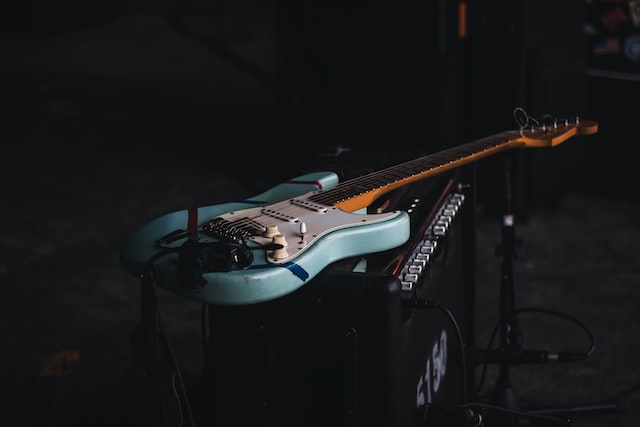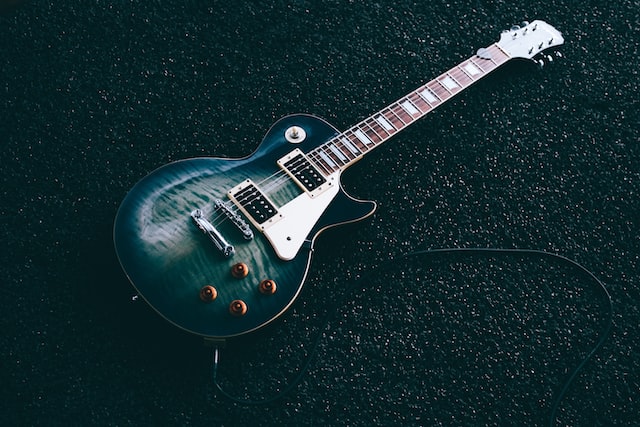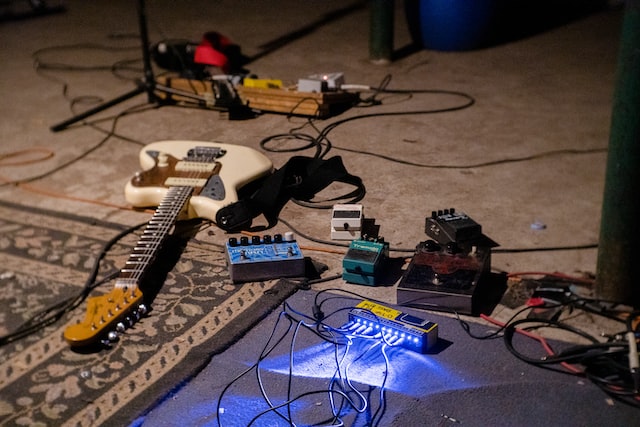BecomeSingers is reader-supported. When you buy through links on our site, we may earn an affiliate commission. Learn More
One of the first questions any aspiring guitar player has in their head is: How much is a guitar?
This is because you get all kinds of confusing information, reviews that are little more than advertisements, and assessments that are nothing else but opinions. This is even worse for beginners since you have no idea what makes a good guitar stand out from the rest.
I’m a conservatory-trained guitar player who has been playing since I was five. In this article, I’ll dispel some myths and offer guidance for all beginners that want to buy their first guitar.
Table of Contents
How Much Does An Acoustic Cost?
Acoustic guitar pricing ranges from $50 to $20,000 and beyond. Many features determine the price, including craftsmanship, wood quality and type, electronics inside (if any), brand recognition, accessories, and other elements. Child-sized guitars are generally less expensive than adult-sized ones.
As you can see, it’s an enormous price range. However, you don’t need a $20,000 guitar if you’re a beginner, and there are good guitars for a fraction of that price.

The best choice when your budget is low is to buy a decent acoustic guitar with no unnecessary accessories. These can add up to a lot of money, and you can always purchase them later. For instance, you might not need an amplifier for your electro-acoustic guitar right now.
What is important to consider, then, when you’re a beginner? The most important thing, in my opinion, is that the guitar should feel comfortable. Hold the guitar, go along each fret, and press the strings. Check whether the guitar feels comfortable making a chord or playing a small passage.
Durability is an important thing, too. Unfortunately, you won’t be able to know this unless you trust reviews from other people. Sound quality is, of course, very important. However, if you need to trade sound quality for comfort, do it. Later on, you can choose a better-sounding guitar as you progress.
Sometimes beginners are confused by different guitar types. For instance, some people use the umbrella term “acoustic” for anything that isn’t an electric guitar. Let’s take a look at the guitars you can find that can be placed under that term.
1. Acoustic guitars with steel strings
Most people think of this when confronted with the term “acoustic guitar”. They are easily differentiated from electric guitars because their body is often larger. Much like their electric counterparts, they use steel strings. Acoustic guitars with steel strings can cost anywhere from $50 to $12,000, and sometimes even more.
These guitars are great for folk, country, pop, and other modern music styles. You’ll get a pristine, detailed sound when strumming chords. You must consider that steel strings might be uncomfortable initially, and the fretboard is many times smaller than other choices, similar to an electric guitar.
2. Acoustic guitars with nylon strings
These guitars are very similar to the ones I mentioned before, except they have nylon strings. Their strings feel very different from steel strings and are thicker. It gives your playing a warmer sound and is very suitable for pop, country, and folk music. Nylon string acoustic guitars can cost anywhere from $75 to over $2,000.
These guitars can be electro-acoustic, too, meaning they can be plugged into a guitar amp. It’s important to consider if you’ll need this feature later on, for example, if you are considering playing live shows. Aside from the strings, the bodies look like steel-stringed guitars. However, don’t confuse them for concert guitars, which come next.
3. Concert guitars
These are the archetypal guitars. When a child is asked to draw a guitar or when you use a guitar emoji, this is very likely what you’ll find. Concert guitars all have very distinctive hourglass-shaped bodies. They can cost anywhere from $400 to $5000.
They use nylon strings and are used for classical music, and many folk styles around the world use it. Many fingerstyle guitar players use it, too. The fretboard is usually larger than the steel or nylon-stringed guitars, which is good for beginners who aren’t still very precise.
How Much Does An Electric Guitar Cost?
Electric guitars can range from $50 to $20,000 and beyond. Some electric guitars from famous guitar players can cost more than $1,000,000. Many factors influence an electric guitar’s price, including the quality of materials, electronic components, and other features.
Like acoustic guitars, getting an expensive electric guitar might be unnecessary when starting out.
That said, the same principles apply. Comfort is at the forefront because an uncomfortable guitar will hinder your progress. Only then comes everything else. Unlike acoustic guitars, it’s much easier for a beginner to distinguish electric guitar sounds from each other.

However, remember that an electric guitar needs to be paired with a guitar amplifier since they don’t sound very good unplugged. The chosen amplifier will play a huge role in determining the overall sound, especially if you like distorted sounds, so consider both things. Prices for amplifiers range similarly to guitars.
When you’re on a low budget or unsure about spending on something you don’t know you’ll like, it’s best to balance both elements. Get a decent guitar and a decent amp, but don’t pair a good guitar with a bad, cheap amp, unless you can plug your guitar in elsewhere or are planning on upgrading at some point.
Just like acoustic guitars, there are many different types of electric guitars. Since these guitars have many features, there are cross-categories, too. For example, you can have double-cut, seven-string guitars or hollow-body, single-cut guitars.
Since all of this might be too daunting, we’ll discuss the most important categories below.
Solid-body electric guitars
These are arguably the most common electric guitars out there. Some well-known guitars in this category are the Fender Stratocaster, Gibson SG, and many others. Be mindful that there isn’t a specific “body shape” for these guitars. However, all of them share a flatter body than any other guitars. They are usually priced between $75 and $35,000.
Hollow-body and Semi-hollow body electric guitars
These guitars are usually priced between $175 and $14,000.
As the name implies, hollow-body guitars are hollow. This means that, unlike solid-body guitars, there’s almost no wood inside. These guitars tend to be bigger than solid-body ones and they look a lot like acoustic guitars. These guitars are primarily used in jazz and blues and have a brighter sound. Due to having air instead of wood inside, they produce sounds with less sustain than their solid counterparts.
On the other hand, semi-hollow-body are a bit smaller. They have a wooden block at the center, where the bridge and pickups (electric guitar microphones) are mounted.
This design allows them more versatility than hollow body guitars, and the most famous example is B.B. King’s “Lucille” guitar, a Gibson ES-355. The main difference between semi-hollow and hollow guitars is how they sound, with semis being more “electric” and hollows being more “acoustic”.
Hollow guitars are prone to feedback (that terrible high-pitch sound that sometimes happens in live shows), while semi-hollow ones are better suited against that. Thus, semi-hollow guitars are more appropriate than hollow guitars to play styles like rock ’n’ roll.
Which Guitar Should I Buy As A Beginner?
Now you understand the different guitar types out there and their main characteristics. But the question remains: which is best for a beginner? Since everyone is different, here’s a detailed explanation of what you must consider.
1. Consider your music style
Roughly speaking, there are two types of beginners: people that want to play the guitar and people that want to play specific music with the guitar. Which group are you in? If you don’t have any preferences, I’d recommend a concert guitar.

For everyone else, the guitar type matters. Let’s have a quick review of the different guitars and their common usage, with some additions:
- Acoustic guitar (steel strings): Pop, Blues, Folk, Rock, Country, etc.
- Acoustic guitar (nylon strings): Jazz, Bossa Nova, Folk, Classical, etc.
- Concert guitar: Classical, Folk, Flamenco, World Music
- Solid-body electric guitar: Rock and related styles like Heavy Metal, Punk, Jazz, Fusion, Pop, Blues, Country, etc.
- Semi-hollow body electric guitar: Jazz, Blues, Rock, Rockabilly, Boogie-Woogie, etc.
- Hollow-body electric guitar: Jazz, Blues
However, use this as a rough guide. Many artists use guitars in different styles than the norm.
2. Nylon vs. Steel strings
Nylon strings have the advantage of needing less tension to be in tune. This means you don’t need to press against the fretboard and strum so hard. It creates a softer playing experience, which is why many guitar teachers suggest beginners get a concert guitar first.
Besides tension, since steel strings are made of metal, they’re much more uncomfortable for a beginner and might cause cuts in your fingertips. However, if you start playing with steel strings, the thickness of nylon strings might be difficult to handle.
If you start playing with steel strings, you’ll have an easier time when using different guitar types since it’s the most common string type shared by acoustic and electric guitars.
3. Check the fretboard
As guitars have different fretboard sizes, this is one of the first things to consider. For instance, a small fretboard might make things difficult if your hands are big.
Another important issue is how it feels to the touch. Some guitars don’t have polished fretboards and feel coarse. Try to avoid this. When you’re more advanced, you can also consider the wood type. Finally, some guitars have more frets than others. Acoustic guitars usually have fewer frets than electric guitars, but there are differences between electric guitars as well. For instance, the Fender Telecaster has one fret less than the Fender Stratocaster.
4. Check the body
Regardless of the body type, you should consider other factors related to the body of any guitar. To start, is it heavy? That can be a concern if you plan on playing while standing up. The width can also be a factor since wider guitars will give you less arm reach.
Second, is there a cutaway? This is critical for electric guitar players since many songs require you to play over the 12th fret, which is difficult to access with non-cutaway guitars.
Finally, if you’re using electro-acoustic or electric guitars, check if the controls’ location is comfortable. This means knobs and switches that are easy to reach and operate without looking at them.
5. Consider the accessories
Some accessories are a must, such as a guitar amplifier for electric guitars. However, there are other less-obvious things that you might need, and it’d be best to purchase a guitar that comes with them or buy them as a kit. Guitar picks (also called plectrums) are a good example.
Guitar picks are crucial for many players, and they come in different thicknesses. Since they’re inexpensive, you could buy different ones and try them all. If you’re an electric guitar player, don’t forget a cable to plug your guitar into an amp.

Then, you must consider straps if you intend to play standing up. Many sizes and styles exist, so be careful with your choice. For instance, a strap for an electric guitar won’t fit a classical guitar.
Do you plan on traveling with the guitar? If so, a case or bag is a must. Cases are much more expensive but offer more protection. However, bags are lighter and easier to store.
6. Consider the price/quality relationship
A good analogy for guitars is cars. More expensive cars offer more features, comfort, better quality parts, etc. However, there’s a threshold when you pay a lot more for an ultra-specific feature.
The same goes for guitars. Cheap guitars tend to have imperfections that, for instance, make your guitar out of tune fast. The cheap bridge may cut your strings more often. The list goes on. However, there’s a sweet spot where guitars get good.
This threshold is subjective, so the best recommendation is to check a couple of guitars for each price range and decide for yourself.
Check our article on Best Free Guitar VST
FAQs
Here are some common doubts people have when looking for guitars.
What is the lowest price of a guitar?
How much should a first guitar cost?
Conclusion
As you can see, there’s a lot to talk about regarding guitar costs, and we’ve barely scratched the surface. However, we covered even more than what you need as a beginner to make a safe choice.
Don’t be deceived by the thought of “cheap is bad, expensive is good”. For instance, one of the guitars I have is a USA Fender James Burton Telecaster. This guitar costs about $2,500. I also have a Squier Telecaster from Japan. It was about $400.
Are there differences? Sure, but the Squier Telecaster has an amazing sound quality, and I’ve used it for live performances many times. The bottom line, each guitar has its use.
My recommendation is to choose a guitar that feels good, and doesn’t take a bank robbery to pay for. Later on, you can always trade it for something more suitable.





